👋 Have a question? I'm Ecee, an AI Chatbot here to help you find what you need.
👋 Have a question? I'm Ecee, an AI Chatbot here to help you find what you need.
John Becker is a content manager, co-host of the Solving Inbound podcast, and full-time They Ask, You Answer enthusiast. He writes about all manner of topics related to digital marketing, sales, branding, growth, and company culture.
Faster sales, better close rates, happier customers, and sales and marketing alignment. I’ll admit, this sounds like one of those too-good-to-be-true lists where you only get to choose one. But no, all four are possible with a savvy sales enablement strategy — and this is more within reach than you might think.
Sales enablement brings your marketing and sales teams together to better serve your customers. As a result, you’ll see a higher close rate and a shorter sales cycle. Your customers will have all the information they need to make their decision, and you’ll hit nothing but green lights on your way home from work today.
Well, maybe the last one is fiction. But hey, you never know.
Use this resource to learn the sales enablement basics. When you get your team on board, you’ll be amazed at what a difference it can make.
Sales enablement is the process of providing resources to your sales team to close deals faster.
Think about it like this: A salesperson meets with a dozen potential customers over the course of a week. Some are good fit prospects. Some are not.
That salesperson gets asked many of the same questions in meeting after meeting:
And so on.
Many of these questions are not specific to the unique needs of one particular prospect. They’re general questions about the buying process, your products or services, or how different options compare.
Sales enablement materials help answer these customer questions so that each prospect feels more well-informed and educated. These materials are created by marketing teams to reduce friction in the sales process.
Sales teams can either share content after a call to provide a more thorough answer than what was provided during the conversation, or they can share this sales enablement content content ahead of a call to get major questions out of the way beforehand.
Sales enablement content can take any form that best suits your team and your customers. Most of our clients use the following formats to communicate with buyers:
At times, they might combine mediums to offer their audience multiple ways to take in the information. For example, they might supplement a blog article with a video. The challenge of this approach is that the two pieces of content (video and text) need to be in lockstep — and when it comes time to update the information, both pieces need to be updated simultaneously.
Within a given piece of content, you will address the most pressing questions your buyers ask. Regular brainstorming sessions with sales and marketing teams will help you develop a backlog of topics. On top of that, marketing team members should regularly watch sales calls to hear questions and concerns directly from the mouths of your buyers.
In most cases, companies begin by focusing on the questions all potential customers want to know.
Common topics covered in sales enablement material include:
While this content will likely live on your website, it probably won’t drive much in the way of organic traffic. But the audience that consumes it (whether through invitation or navigation) will have high buying intent. Expect higher time on page and lower bounce rates than with other pages.
You can think of every question a prospect asks as an impediment to a sale. If a prospect needs more information, he’s not ready to buy.
Therefore, when something answers a prospect’s question, it removes an impediment and reduces friction in the sales process.
Sales enablement works. According to data from Learn Hub, most companies implementing a sales enablement strategy saw a 6%-20% increase in sales.
But the data only tells half the story. Sales enablement boosts the confidence of every sales rep. With a library of content behind them — from blog articles to buyer’s guides to FAQ pages — any member of a sales organization can confidently respond to any question that comes to them from a prospect.
Melissa Prickett is a tenured salesperson with more than two decades of experience. She explains sales enablement like this:
Sales enablement helps me do my job better. I know that every time I get a question from a prospect, I have a thorough, vetted answer I can hand them. Because I work so closely with the marketing team, I am confident this content is 100% accurate. And, if I end up hearing a totally new question, I bring it to my marketing team and they create new content specifically for that question.
And it’s not just the sales team that benefits.
Every prospective customer is positively impacted by sales enablement as well. If a buyer is able to get all of her general questions answered ahead of time, she can spend her meeting with a sales rep talking about her own unique challenges. If she already has product specs, information about the cancellation policy, and customer testimonials at her fingertips — and she gets these ahead of a sales call — the conversation can be completely tailored to her needs.
It’s no wonder that searches for “sales enablement” have gone up every year on record, according to Google Trends, with some increases of as much as 51%, year over year.
Sales enablement doesn’t happen by accident. Without the dedication of the sales and marketing teams, the initiative will fail.
Each business will need to determine the best makeup of its own sales enablement team, but here are some general roles and responsibilities to use as guidelines.
Sales enablement must be a joint effort of your marketing and sales teams. That’s not to say that everyone from both teams needs to contribute, but representatives from each need to have their hands in the process.
Although these roles are critical, they will not accomplish much if there is not buy-in from above for the whole initiative. Company leadership needs to see the value that a sales enablement strategy can deliver so they will be willing to have team members give up their time to contribute to it.
The biggest commitment will be from the marketing team: The content writer and videographer will be diverting attention from other tasks (website or email copy, social media, YouTube videos, or traffic-driving content) toward producing sales enablement content that will not bring in much traffic.
The most complete and proven sales enablement framework is They Ask, You Answer, developed by Marcus Sheridan in the years after The Great Recession of 2008.
At that point, Marcus ran a pool installation business with a few business partners. When the financial crisis hit, his industry was devastated. The discretionary income his customers were planning on spending on their backyard suddenly was no longer discretionary. Almost overnight, Marcus found himself in the red, with his business account overdrawn as dozens of customers backed out of their agreements.
Marcus realized that as long as the economy was struggling he was going to have fewer opportunities to sell. His solution was to remove as many impediments as he could. Any question, objection, or concern he’d ever heard from buyers in the past became an idea for content. No question was out of bounds.
If someone wanted to know about the drawbacks to fiberglass pools (the only kind of pools he sold), he’d address it openly and honestly on the company website. If someone wanted to know how his company compared to the competition in the area, he’d address it without bias or angle.
For every question, he provided an answer.
This approach spawned a book, and, eventually, a movement. They Ask, You Answer.
But back in 2008, Marcus was just interested in trying to save his business.
And he did. The more customer questions he answered, the more his close rate inched up.
It wasn’t just prospects who were consuming the content. Because Marcus, his sales reps, and the rest of the organizatioon put every answer on the company website, more top-of-the-funnel searchers found his content too. In time, his site, River Pools, became the most trafficked pool website in the country. They were reaching people far beyond their Virginia service area.
To evaluate any new content idea, the metric was the same: Is this a question we hear from buyers? If so, we should answer it. If not, we should talk to the sales team about what they’re actually hearing from prospects.
Today, businesses around the world use They Ask, You Answer to guide their sales enablement strategy.
Any content specifically aimed at prospects in the sales process can be sales enablement content.
But when your sales team uses this content with prospects, you reach a different level. Each of the examples below is available on the company’s website. Any casual searcher could find it. But each is also used in the sales process by these organizations, “assigned” to prospects ahead of a sales meeting.
Those reps know the questions that most often come up at each stage in the sales process. When sales and marketing teams work to answer prospects' questions ahead of time, sales reps can have more productive conversations with less friction.
What Are Operating Expenses for Office Space in Austin, Texas? Here, Texas-based commercial real estate business Aquila Commercial outlines exactly what a buyer should expect to pay.

Welded Chain Slings vs. Mechanical Chain Slings… What’s Best for Me?: Mazzella is a lifting and rigging specialist in the Midwest. For businesses looking at options for their warehouse or factory, this article provides an unbiased comparison that can help them make their decision more easily.
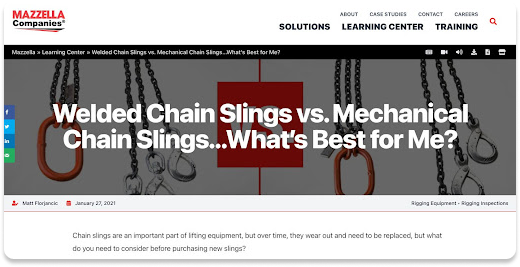
Choosing an Investment Database: How Marketplace Compares: Financial firm Dakota puts its own marketplace option up against others in the industry. While any buyer would take this information with a grain of salt, author (and CEO) Gui Costin sings the praises of competitors, making this feel more like a reference material and less like a sales pitch.
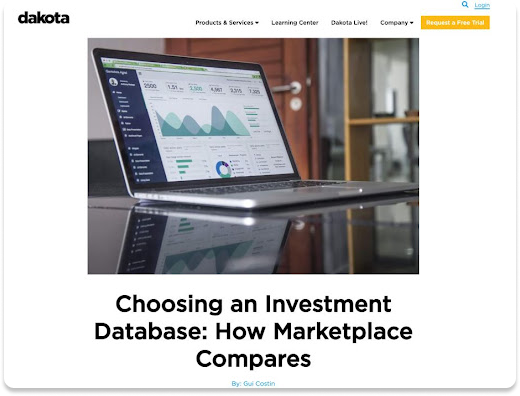
But sales enablement content is not just written. This example comes from RoofCrafters. Project estimators send these out ahead of any meeting with a potential customer:
If you were in the market for a roof, would this satisfy a number of your initial questions? If so, it’s doing its job.
There are an ever increasing array of tools and platforms that can streamline a sales enablement program and measure its effectiveness. Not only can a sales enablement platform help you organize content to send to your prospects, but you can see who opened what, how long they spent on each section, and whether or not they shared it with others at their company.
If your sales enablement material is hosted on your website, you can use your CMS to track engagement, including traffic, dwell time, and attributed revenue.
Expect to see lower traffic numbers and high time per page view, as with this piece, with data from HubSpot:

Look to break down your traffic metrics by filtering out organic search so you can specifically focus on email marketing or referrals or however else you share your content.
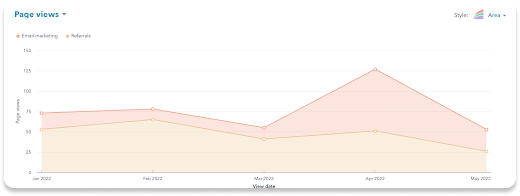
But your CMS is not the only tool at your disposal.
Your sales reps will be sharing sales enablement content with your prospects. But how will they actually do this? The simplest method is to just email a list of URLs, but this is also the least engaging or visually pleasing.
A sales enablement platform like Paperflite and SalesReach allows users to quickly build customized landing pages specifically for a given prospect.
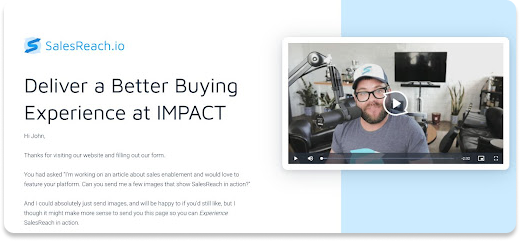
Sales reps can organize colorful resources and send them in a way that is beautifully laid out and clickable.
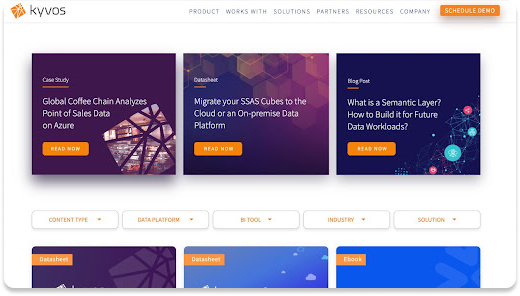
These sales enablement platforms also allow you to track engagement metrics to see how your prospects interacted with the content you shared. The data from your sales enablement software can be used to evaluate and improve the content you are sending to potential clients.
You’ll need a solid process to put your sales enablement plans into action. Assuming you already have enthusiastic buy-in from leadership, you should:
Run brainstorm sessions: At a regular cadence, get people from your marketing and sales teams together to brainstorm topic ideas. Try to specifically focus on the questions being asked in recent sales calls. The content writer should ask questions to get to the bottom of any topic idea:
We recommend running brainstorms twice per month to start, and then switching to once a month.
View sales calls: On top of the brainstorm sessions, all content producers (and marketers in general) should view sales call recordings at least every week. This helps the writers get to know the customers and ensures the content will be on target.
Produce content: With the question in hand (along with plenty of background knowledge), the content writer and videographer can produce the content. If they need expertise beyond their own knowledge or research, they should plan to interview subject matter experts (SMEs) inside the company.
Share the content with the sales team: At each brainstorm session, the content producers should present the content that’s been created since the last meeting. Walk the sales team representative through it so he starts to trust it. He can then start using it immediately with prospects.
Gather data: Once a piece is in the hands of the sales team, you can begin to gather data to track its efficacy. Be forewarned, though, that sales enablement content is going to have limited views, so be sure you’ve got enough data to draw meaningful conclusions.
Important metrics to track include:
But don’t limit your data to what you can see from individual pieces of content. Work with the sales team to track:
A good sales enablement strategy should improve all of these.
Repeat: At first, there will be a seemingly endless backlog of questions and content ideas. Over time, you’ll build up a library of sales enablement content that will be always at your sales team’s fingertips.
As this happens, shift to once a month brainstorms and put more focus on keeping content up to date. If your company changes prices or updates its product catalog, you’ll have to update content accordingly.
Sales enablement allows you to deliver the exactly right information to the right person at the right time. With a library of vetted content specifically intended for your prospects, your sales team can get ahead of the major objections they hear at each stage of the sales process.
Sales enablement success begins when you acknowledge it as priority. Without the right team members putting in time, it won’t get off the ground — and you won’t see results. Here’s how to get started:
Produce four pieces of content per month that answer customer questionsand work with your sales team to make sure these are thorough, correct, and digestible.
Rinse and repeat.
As sales enablement becomes more ingrained in your company culture, expect to see sales reps sending content ahead of time (a process we call “assignment selling”) to answer questions before they even come up.
Sales enablement success means that you can get this exciting future:
A prospect enters a sales call with all of her general questions answered ahead of time. She already knows if she’s a good fit for your products or services. She can now ask specific questions about her unique needs. What follows is a more fruitful sales conversation that puts both parties on equal footing. Because the buyer has the information she needs, trust is established early. The sales process becomes frictionless. Both your company and your buyers benefit. Truly a win-win.